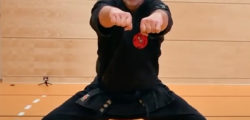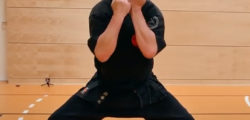The 2nd Tai Tsuku already makes higher demands on the Kempoka, although it is still one of the short kata in style. But those who aspire to the orange belt will dive deeper into basic movement principles here.
Only 11 stand changes count for those who take the time to do so. But often different punching or blocking techniques are performed in just one position. Important for the second Tai Tsuku is the use of the own body. Already in the second movement sequence one of the key sequences of the whole Kata: A large, allegedly heavy and grasping opponent is taken up with both hands, presses the practicing person deep into his Zenkutsu Dachi, only to be pushed back again explosively. The work of the back leg in Zenkutsu Dachi is emphasized.
If both elbows remain at the short ribs, the two-handed pushback comes from the body and not from the arms. They are only moved forward when the opponent is already in backward motion. This way even lightweight Kempoka manage to push a heavier opponent away. However, the necessary understanding of body mechanics is required. I only understood it after years of practice. The Age Uke is not a defense here, the opponent is already in the backward movement, but rather a punch under the grabbing arms or in the face, depending on the interpretation. The Nukite fingertip thrust then ends this attack attempt.
The second key passage comes shortly afterwards. The attacker grabs the Gi or tries to choke with both hands from the front. Again, the techniques only work if they are combined with a significant change in height. In a large backswing movement both arms go up. Again the elbows are used, this time to break the grip. Very important again is the use of your own body weight by lifting and lowering the middle of the body. Only with the strength of the arms nobody, lighter or smaller, will break the grip of the attacker.
Only 11 booths? Orange belt only? No way! Also with this kata the own level of development becomes very clear. The longer you are there, the further you get in your efforts, the more often you run this basic kata. And the more often you run it, the more it will change. Promise!












